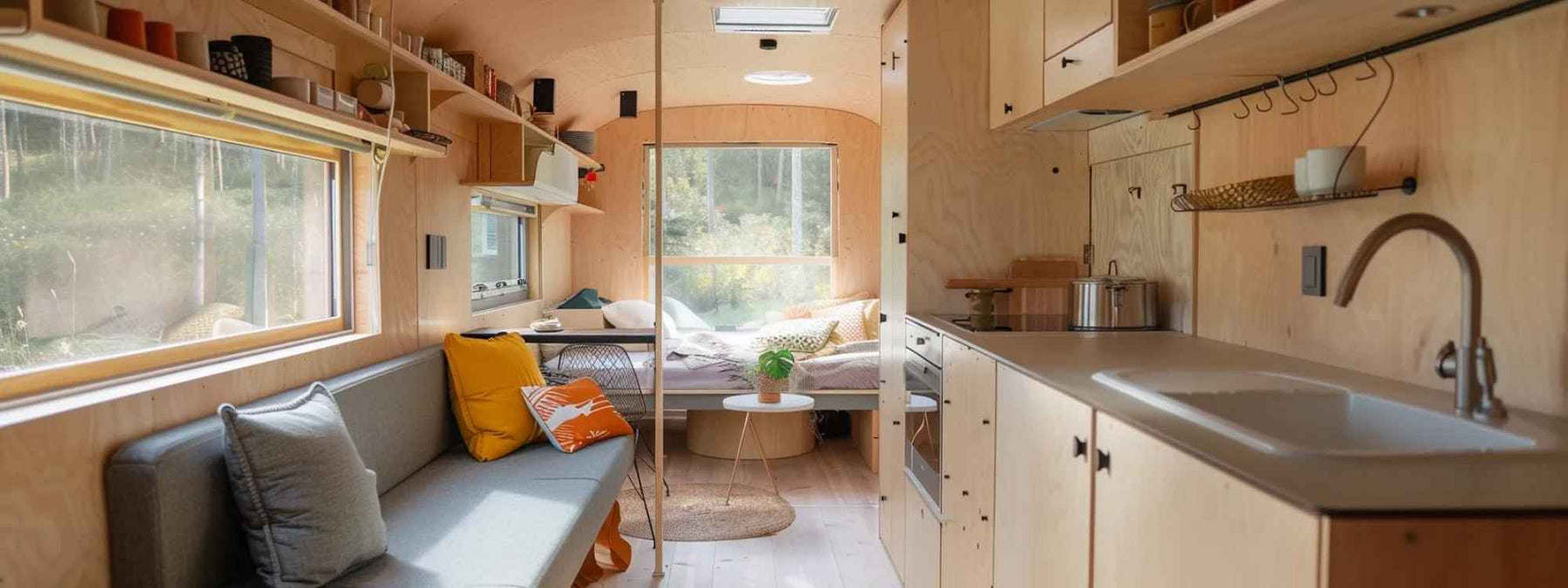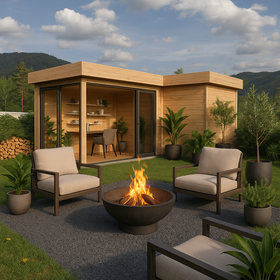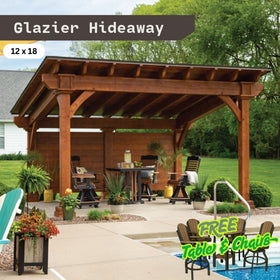512-777-0154

Essential Items for Your Tiny House
Downsizing sounds appealing until it’s time to make some tough choices. Like realizing your favorite sectional sofa won’t fit through the front door. Or discovering your stack of cookbooks now has nowhere to live.
Moving into a tiny house and committing to simple living means being intentional. You’re not just shrinking your home; you’re shifting your mindset. It’s about choosing clarity over clutter. Functionality over fantasy.
You might love the idea of hanging plants and vintage rugs. But first, you need a comfortable place to sleep, a kitchen that works, and storage that doesn’t leave you feeling cramped.
In this post, you’ll learn exactly what to keep and what you can safely leave behind with a few tiny house design ideas to create your dream home. Because living tiny doesn’t mean giving up everything you love, it just means focusing on what truly matters.
What Does a Tiny House Need?
When space is limited, everything has to earn its keep. That means forgetting the “dream interior design list” for now and focusing on what keeps your day-to-day life running smoothly.
Tiny homes like Sawmill Structures BlueWater Bungalow 160 aren’t about having less just for the sake of it. They’re about having enough and making it work harder. So, before you think about small house interior design extras or nice-to-haves, cover the basics:
- A place to sleep that’s comfortable and doesn’t take over your entire floor plan
- A way to cook and eat — even if that’s a single burner, a mini fridge, and a fold-down table
- Bathroom essentials that fit the space (and your plumbing setup)
- Storage that hides clutter without cramping your style
- Heating, cooling, and electricity that keep the place livable year-round
- A setup for daily life — working, reading, exercising, or whatever you do regularly
Everything else is secondary.
It also helps to think modular in small homes. If something can fold, stack, roll, or serve more than one purpose, it’s a win. Especially if your small houses are mobile. Power sources, weight, and access all come into play when you're on the move.
5 Best Tiny Homes Essential Items
Moving into a mini house means choosing your tiny house design carefully. You can’t have everything, so the essentials have to work harder. But knowing what those essentials are? That’s the tricky part.
To make things easier, here’s a short, practical guide to the five most important areas of any small modern house.
1. Small Beds
- Murphy beds fold into the wall when you’re not using them.
- Lofted beds free up the floor underneath for work or storage.
- Convertible sofas turn your living room into a bedroom in seconds.
- Built-in nooks work well in corners or custom layouts.
- Add drawers or lift-up lids for extra storage.
- Use vacuum-sealed bags to stash out-of-season clothes or bedding.
- Look for frames with built-in compartments instead of bulky box springs.
In small spaces, dead space is your enemy. Sleep on it. Store in it. And make sure it works for you, day and night.
2. Kitchen Setup

A tiny kitchen doesn’t have to mean living off ramen noodles and canned beans. Sure, you might not have space for that huge French-door refrigerator or cabinetry you’ve always dreamed of. But with a little smart planning, you won’t feel like you’re stuck cooking over a campfire either.
First things first, appliances. Choose carefully, because you’ll see and use them every day.
- Induction cooktops heat fast and don’t hog countertop real estate.
- Combo microwave-oven units handle most baking and reheating tasks. Do you really need a full-sized oven? Probably not.
- Compact, energy-efficient fridges will hold more than you think, especially if you don’t waste space on unnecessary groceries.
Next, your kitchenware. Focus on items that stack, nest, or fold. Think bowls, measuring cups, and colanders that fit together. Bulky knife blocks look nice, but they eat precious counter space. Pick two or three sharp knives that do it all, plus a sharpener.
The same goes for pans. You can cook almost anything with a single great cast iron skillet and maybe one small saucepan. More isn’t always better, especially in tiny kitchens.
Finally, don’t ignore your walls and ceiling. Pegboards, hanging baskets, and magnetic knife strips are your best friends. Hooks are surprisingly useful, too. Your kitchen may be small, but vertical storage will make it mighty.
3. Bathroom
Tiny bathrooms get a bad rap. And sure, they’re small. But small doesn’t have to mean uncomfortable. It’s all about being clever with the space you’ve got.
Start with the basics. Tiny showers that tuck into corners are an amazing idea. Pair that with a compact, wall-mounted sink to free up valuable floor space.
And don’t overlook composting toilets. They’ve come a long way. Modern ones are odorless, easy to maintain, and eco-friendly. You’re not living in a castle, but you don’t have to go medieval, either.
Storage in a small bathroom takes some creativity. Waterproof corner shelves and wall organizers keep toiletries tidy without getting soggy. Hooks and baskets on walls or doors are your secret weapon against clutter.
Speaking of toiletries, ditch bulky shampoo bottles for bar soaps and solid shampoos. They save space and cut down on plastic waste.
4. Storage

When you live in your GardenHouse24 USA Henning 70 Garden Room, storage becomes your secret weapon. But here’s the catch: too much storage can quickly turn into clutter. And clutter is exactly what you’re trying to avoid.
So, how do you strike that balance?
First, think built-in, not add-on. Every piece of furniture should double as storage:
- Benches and ottomans with hidden compartments inside.
- Stairs that secretly house drawers for shoes or linens.
- Fold-out desks or tables that disappear into the wall when you’re done working or eating.
Avoid cabinets if you can; they eat floor space. Floating shelves like Fireside Lodge Barnwood Hanging Locker keep things clean, open, and accessible. Plus, they help you keep things tidy, since everything stays in sight.
Second, embrace your vertical space. Walls aren’t just walls, they’re storage waiting to happen:
- Hooks for bags, jackets, pots, and pans.
- Hanging baskets to hold everyday items.
- Tall cabinets or shelves stretching up instead of out.
And don’t overlook the ceiling. Hang your bike, suspend your plants, get creative.
Finally, keep things minimal. The "one in, one out" rule is your friend. If you bring something home, something else has to go.
5. Heating, Cooling, and Electricity

When your GardenHouse24 USA Lerum 70 Garden Room fits in a parking spot, climate control gets interesting. You can't exactly stick a massive central heating system in a tiny house. And window units? They waste more space than they’re worth.
So what do you do?
Mini-split systems are usually the answer. Compact, quiet, and energy-efficient, they handle both heating and cooling without taking over your limited space. For extra chilly days, a small portable space heater tucked away can be a lifesaver. And don’t underestimate the power of a good fan and ceiling vents; they’ll keep air moving without clutter.
But here’s a secret: insulation matters more than you think. It's not flashy or exciting. But without proper insulation, you'll waste energy and money trying to stay comfortable. Don’t overlook it.
Then there’s power. Shore power (plugging into the grid) makes life easy. Mobile or off-grid? Solar panels or a quiet generator become your best friends. Portable battery banks can help smooth things out, giving you backup when the sun disappears.
Finally, consider smart power strips. They manage your usage automatically, protect your gadgets, and save precious space. Little things add up, especially when your home is tiny.
Few Tiny Luxuries That Are Totally Worth It
- Bluetooth projector: Forget bulky TVs. A compact projector lets you stream your favorite movies or shows straight onto any wall. Plus, it packs away neatly when not in use.
- Fold-down outdoor deck: Your living space can double instantly. A simple, hinged deck adds an outdoor area for relaxing or eating. And when you’re done? Fold it back up, and it disappears completely.
- Heated flooring: Cold climates can turn your tiny home into an icebox. Heated flooring might seem like a luxury, but it's efficient and saves on heating bills long-term. Plus, your feet will thank you every morning.
- Water filter system: Clean drinking water matters. Installing a quality water filtration setup gives you peace of mind and tastes way better than lugging bottled water around.
- Foldaway laundry drying rack: Skip the laundromat dryer. A wall-mounted rack pulls down easily for drying clothes, then folds flat to save precious space.
Luxury in a tiny house isn’t about impressing anyone. It's about practical comforts that truly improve daily life.
Related: 12 Ways to Decorate Your Modern Tiny House
What Really Counts When Choosing Tiny House Essentials?
Living in a tiny house isn’t about giving things up. It’s about choosing the right things and letting go of the rest. You don’t need more. You need what works.
That means pieces that serve a purpose. That fits your routine. That makes everyday life a little easier. The coffee mug you use. The chair that doesn’t block the doorway. The bed that holds storage underneath.
What counts as “essential” will change over time. Maybe you can add a desk later. Maybe your cooking setup gets an upgrade. That’s the point, tiny living should stay flexible. Build a setup that fits your life now, but leaves room to adjust as your needs shift.
And if you’re still in the dreaming phase, take your time. Start with the basics. Pay attention to how you live in your current space. What do you reach for every day? What stays untouched for weeks?
If you’re planning to build or buy a tiny home, check out our outdoor freedom rooms.








